
In order to increase the productivity of industrial machines, such as automatic assembling machines, various transportation machines, machines tools, and so on, their operating parts have been made to work faster. However, the resulting impact, vibration, and noise have caused adverse effects on the machine's performance and on the working environment. A soft absorber is an extremely convenient hydraulic buffer that can solve such problems. There are similar devices made of rubber, springs, or devices that use pneumatic pressure, but none of them rival the impact absorption characteristics of the hydraulic type, as illustrated below.
| Rubber | The rubber's elastic deformation captures the impact energy, and this energy is then accumulated in the rubber. As a result, the accumulated energy works as a repulsive force, and there is a high risk of a rebound being tenerated. Therefore, it is not an efficient impact absorber. On the other hand, it is extremely affordable and its installation is easy. | 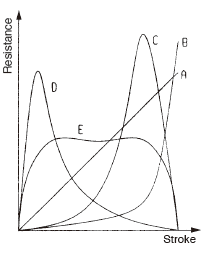 |
|---|---|---|
| Spring A |
Like the rubber type, it captures the impact through elastic deformation and stores it as elastic energy. Once the impelling force is diminished, the stored energy is likely to repel as it does in the rubber type, causing a rebound. | |
| Pneumatic pressure B |
It uses pneumatic pressure to absorb impact similar to the rubber and spring types, but because the compressed air is released to the atmosphere through an orifice, the energy does not accumulate. However, unless the rapid compression and releasing action through the orifice is well balanced, a rebound occurs as it does in the spring type. | |
| Hydraulic pressure C D E |
It uses oil's velocity-squared resistance as well as viscosity resistance to absorb the energy, which is then converted into heat energy and released into the atmosphere. As a result, extremely efficient impact absorption is possible. A relatively compact design is capable of absorbing large impacts, and depending on its structure, the impact absorption characteristics can be modified as well. |
As shown below, when an object hits the piston rod, the motion is transferred to the oil in the pressure chamber through the piston rod. As a result, the oil inside the pressure chamber flows out of the orifices located in the inner tube. This causes compression in the pressure chamber. The product of this hydraulic pressure and the pressureapplied area of the piston is resistance, which acts on the colliding object. Soft absorbers use this resistance to apply the brake to the colliding object, slowing it down. The hydraulic pressure generated inside the pressure chamber is proportional to the square velocity of the colliding object, as long as the orifice size, oil viscosity, etc. are constant. This is called velocity-squared resistance.

Soft absorbers are divided into two major categories based on how the orifice area changes, and they are further divided into four groups according to their absorption characteristics. Each of the absorption characteristics is described below.
| Constant orifice | Stroke-dependent orifice | ||
|---|---|---|---|
| Single-orifice type | Multiple-orifice type | Multiple varying orifice type | Groove-orifice type |
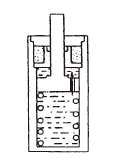 |
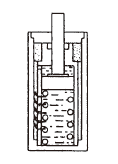 |
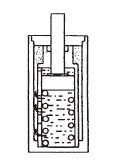 |
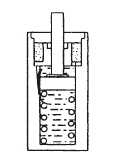 |
| There are three structures in a single-orifice type: a dashpot structure that utilizes the space between the piston and cylinder tube; a single tube structure in which orifices are provided in the piston; and a double tube type single orifice structure (adjustable). Their resistance characteristics are shown in the graph to the right. When the piston moves within the cylinder tube, the product of the pressure generated in the inner tube and the piston area becomes the resistance. Throughout the entire stroke, the orifice area is constant. The resistance spikes immediately after the impact, and as the stroke advances, the speed decreases and the resistance decreases with it. | It has a double structure comprising an outer tube and an inner tube. Similar to the single-orifice type, the resistance is the product of the pressure generated inside the inner tube when the piston is stroking and the piston area. The orifice area at the moment of impact is larger compared to the single type, and because it gradually decreases as the stroke advances, it can suppress the overall resistance. Theoretically, the resistance during a stroke can be maintained constant. Depending on the orifice design, the resistance characteristics can be modified according to the impact conditions. | Although it has the same structure as the multiple-orifice type, resistance characteristics that are suitable for the intended use can be obtained rather than a constant damping force. FWM series is designed to absorb the kinetic energy in the first half of the stroke and to perform speed control during the last half of the stroke. Because of this, ideal energy absorption with respect to the air-cylinder thrust can be obtained. | Through a single tube system, the orifice groove provided on the inside wall of the tube changes as the stroke advances. Similarl to the multiple type, it has a large orifice area at the beginning of the stroke. As the stroke advances, the orifice area becomes smaller, suppressing the resistance. In addition, because the orifice area can be changed on a continuous basis, the resistance fluctuates less compared to the multiple type. Because of this, optimal energy absorption can be realized. |
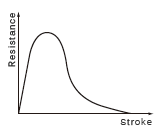 |
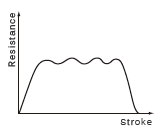 |
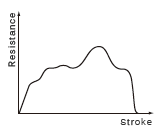 |
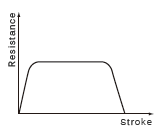 |